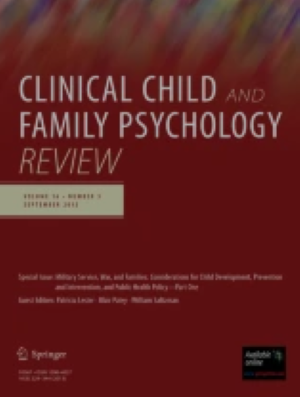霸凌、受害与儿童青少年五大人格特质的关系:一项元分析。
IF 6.1
1区 心理学
Q1 PSYCHOLOGY, CLINICAL
引用次数: 0
摘要
之前对五大人格特质的研究得出了不一致的结论,即它们在欺凌中的作用。本研究首次使用三层次元分析来调查儿童和青少年中五大人格特征与欺凌和受害之间的关系,并考虑了平均年龄、女性比例和欺凌类型(传统欺凌与网络欺凌)等调节因素。我们纳入了29项研究(67种效应大小),涉及26328名参与者,时间跨度从2002年到2024年,跨越多个国家。结果表明,尽责性和亲和性与霸凌和受害呈负相关,而神经质与霸凌和受害呈正相关。开放性与受害无关,但与欺凌负相关。外向性与欺凌或受害无关。平均年龄和女性比例的调节作用不显著;然而,欺凌的类型缓和了其中的一些关联。其中,网络欺凌中的受害行为与外向性和神经质性无显著相关,而传统欺凌中的受害行为与外向性呈显著负相关,与神经质性呈显著正相关。在欺凌方面,尽责性和亲和性与传统欺凌的关联显著强于网络欺凌。研究还发现,出版年份并没有显著调节大多数关系,这表明人格特质和欺凌行为之间的联系一直保持稳定。这些结果有助于早期识别儿童和青少年中的欺凌者和受害者,以确保及时干预。本文章由计算机程序翻译,如有差异,请以英文原文为准。
Relationship Between Bullying, Victimization, and the Big Five Personality Traits in Children and Adolescents: A Meta-Analysis.
Previous research on the Big Five personality traits has produced inconsistent findings regarding their role in bullying. This study is the first to use a three-level meta-analysis to investigate the associations between the Big Five personality traits and bullying and victimization among children and adolescents, considering moderators such as mean age, female percent, and type of bullying (traditional vs. cyberbullying). We included 29 studies (67 effect sizes) with 26,328 participants, spanning from 2002 to 2024 across multiple countries. The results showed that conscientiousness and agreeableness were negatively associated with bullying and victimization, while neuroticism was positively associated with both. Openness was unrelated to victimization but negatively associated with bullying. Extraversion was not associated with bullying or victimization. The moderating effects of mean age and female percent were not significant; however, the type of bullying moderated some of these associations. Specifically, victimization in cyberbullying was not significantly associated with extraversion or neuroticism, but in traditional bullying, victimization showed a significant negative association with extraversion and a significant positive association with neuroticism. Regarding bullying, conscientiousness and agreeableness exhibited significantly stronger associations with bullying in traditional bullying compared to cyberbullying. The study also found that publication year did not significantly moderate most of the relationships, indicating that the associations between personality traits and bullying behaviors have remained stable across time. These results could help for the early identification of bullies and victims in children and adolescents to ensure timely interventions.
求助全文
通过发布文献求助,成功后即可免费获取论文全文。
去求助
来源期刊

Clinical Child and Family Psychology Review
PSYCHOLOGY, CLINICAL-
CiteScore
10.50
自引率
4.30%
发文量
45
期刊介绍:
Editors-in-Chief: Dr. Ronald J. Prinz, University of South Carolina and Dr. Thomas H. Ollendick, Virginia Polytechnic Institute Clinical Child and Family Psychology Review is a quarterly, peer-reviewed journal that provides an international, interdisciplinary forum in which important and new developments in this field are identified and in-depth reviews on current thought and practices are published. The Journal publishes original research reviews, conceptual and theoretical papers, and related work in the broad area of the behavioral sciences that pertains to infants, children, adolescents, and families. Contributions originate from a wide array of disciplines including, but not limited to, psychology (e.g., clinical, community, developmental, family, school), medicine (e.g., family practice, pediatrics, psychiatry), public health, social work, and education. Topical content includes science and application and covers facets of etiology, assessment, description, treatment and intervention, prevention, methodology, and public policy. Submissions are by invitation only and undergo peer review. The Editors, in consultation with the Editorial Board, invite highly qualified experts to contribute original papers on topics of timely interest and significance.
 求助内容:
求助内容: 应助结果提醒方式:
应助结果提醒方式:


